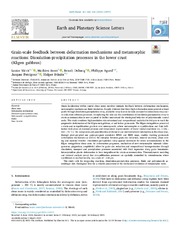| dc.contributor.author | Mérit, Louise | |
| dc.contributor.author | Soret, Mathieu | |
| dc.contributor.author | Dubacq, Benoit | |
| dc.contributor.author | Agard, Philippe | |
| dc.contributor.author | Précigout, Jacques | |
| dc.contributor.author | Stunitz, Holger | |
| dc.date.accessioned | 2025-03-18T08:43:44Z | |
| dc.date.available | 2025-03-18T08:43:44Z | |
| dc.date.issued | 2025-03-02 | |
| dc.description.abstract | Strain localization within crustal shear zones involves intricate feedback between deformation mechanisms,
metamorphic reactions and fluid circulation. Despite evidence that these high-deformation zones proceed at least
partly through dissolution-precipitation creep, available creep laws so far only account for dislocation creep and/
or solid-state diffusion processes. Deciphering the role and the contribution of dissolution-precipitation creep to
strain accommodation is now required to further understand the rheological behavior of polymineralic crustal
rocks. This study combines high-resolution microstructural and compositional analytical techniques to track the
progressive deformation of the Kågen metagabbros, at and below grain scale. The Kågen metagabbros preserved
a strain and re-equilibration gradient over outcrop-scale, where metamorphic re-equilibrations and fluid infiltration took place at constant pressure and temperature representative of lower crustal conditions (ca. 1 GPa -
660 ± 25 ◦C). The comparison and quantification of chemical and microstructural information in this shear zone,
through pixel-per-pixel and grain-per-grain correlated EPMA and EBSD maps, enables tracking grain-scale
deformation mechanisms as well as the interplay between grain size reduction, mineral reactions, phase mixing and material transfer. Dissolution-precipitation creep appears dominant for strain accommodation in the
Kågen metagabbros shear zone. As deformation progresses, nucleation of new metamorphic minerals (clinopyroxene, plagioclase, amphibole) allow for grain size reduction and compositional homogenization through
dissolution, transport and precipitation processes associated with fluid ingression along grain boundaries.
Intracrystalline plastic deformation is here insignificant for strain accommodation. Thermodynamic modeling
and textural analysis reveal that re-equilibration processes are spatially controlled by microdomains where
equilibrium is reached locally, on a scale of ~100 µm.
This study calls for integrating reactions, dissolution-precipitation processes, fluids and polymineralic assemblages into rheological laws for a reliable assessment of the mechanical evolution of metamorphic rocks. | en_US |
| dc.identifier.citation | Mérit, Soret M, Dubacq B, Agard, Précigout J, Stunitz H. Grain-scale feedback between deformation mechanisms and metamorphic reactions: Dissolution-precipitation processes in the lower crust (Kågen gabbros). Earth and Planetary Science Letters. 2025;656 | en_US |
| dc.identifier.cristinID | FRIDAID 2366987 | |
| dc.identifier.doi | 10.1016/j.epsl.2025.119275 | |
| dc.identifier.issn | 0012-821X | |
| dc.identifier.issn | 1385-013X | |
| dc.identifier.uri | https://hdl.handle.net/10037/36710 | |
| dc.language.iso | eng | en_US |
| dc.publisher | Elsevier | en_US |
| dc.relation.journal | Earth and Planetary Science Letters | |
| dc.relation.projectID | info:eu-repo/grantAgreement/EC/European Research Council/865411/EU/ Predicting Energy Release in fault Systems: Integrating Simulations, Machine learning, Observations/PERSISMO | en_US |
| dc.rights.accessRights | openAccess | en_US |
| dc.rights.holder | Copyright 2025 The Author(s) | en_US |
| dc.rights.uri | https://creativecommons.org/licenses/by/4.0 | en_US |
| dc.rights | Attribution 4.0 International (CC BY 4.0) | en_US |
| dc.title | Grain-scale feedback between deformation mechanisms and metamorphic reactions: Dissolution-precipitation processes in the lower crust (Kågen gabbros) | en_US |
| dc.type.version | publishedVersion | en_US |
| dc.type | Journal article | en_US |
| dc.type | Tidsskriftartikkel | en_US |
| dc.type | Peer reviewed | en_US |


 English
English norsk
norsk
